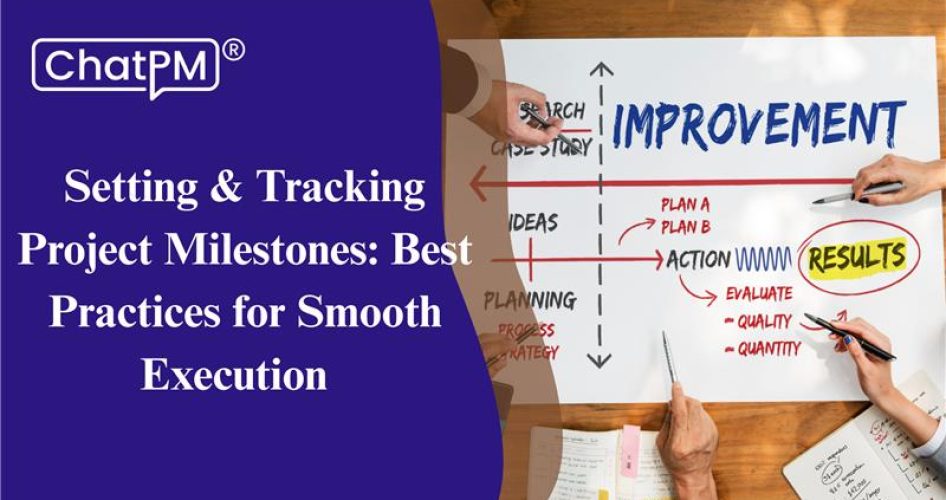Have you ever started a project only to feel lost midway, unsure if you’re making real progress? How do you ensure your team stays on track and meets deadlines without confusion? This is where project milestones come in. Milestones act as checkpoints, helping you measure progress and keep everything moving smoothly. But how do you set them effectively? And what’s the best way to track them? Let’s explore the best practices for setting and tracking project milestones to ensure seamless execution.
What Are Project Milestones and Why Do They Matter?
Milestones in project management are significant events that measure progress towards a goal. They serve as checkpoints, indicating when a crucial phase in the project is accomplished. Unlike ordinary tasks, which need daily effort, milestones commemorate significant accomplishments such as beginning a new phase, finishing an essential deliverable, or assessing progress. Milestones are flexible, which is one of their finest features. What constitutes a milestone is determined by the project and team; there are no hard and fast standards. For some, completing a design is a milestone, yet for others, it is a budget review or an essential meeting. However, this flexibility can occasionally lead to misunderstanding, particularly when attempting to distinguish milestones from tasks or difficulties. While tasks need particular labor, milestones are merely highlighting progress.
How to Set and Track Project Milestones?
1. Define Your Project Goals and Key Deliverables
Before creating milestones, you must first grasp your project’s objectives. Define success and identify the key deliverables that will lead to completion. Without clear goals, milestones might become meaningless markers rather than useful progress indicators. For example, if you’re creating a software program, important deliverables can include finishing the design process, building main functionality, and doing final testing. Each of them is a vital step towards project success. Setting specific goals ensures that milestones are consistent with your overarching vision and provides a disciplined path for your team. A common understanding of what has to be accomplished allows everyone to stay focused and motivated throughout the project. Additionally, well-defined milestones make it easier to measure progress and make necessary adjustments when challenges arise, ensuring the project stays on track.
2. Identify Key Milestones Within the Project Phases
Projects are frequently separated into phases, such as planning, implementation, and completion. Each phase has distinct objectives, and significant changes between them can act as natural milestones. For example, in a building project, laying the foundation, finishing the framework, and doing the final safety inspection can all be major milestones. Similarly, in a marketing effort, building a website, generating a certain number of leads, and analyzing performance may all be considered milestones. By identifying key transition points, you can guarantee that milestones represent actual progress rather than small activities. These indicators help teams keep on track and maintain a consistent workflow. Furthermore, well defined milestones improve stakeholders’ comprehension of project progress. They serve as checkpoints that indicate whether the project is on schedule or if adjustments are needed. Properly placed milestones provide motivation and direction, helping teams move smoothly from one phase to the next.
3. Integrate Approvals and Reviews as Milestones
Many projects require approvals and reviews at various stages to guarantee quality and alignment with the goals. These checkpoints can be used as milestones to track progress and ensure responsibility. Milestones in product development can include stakeholder acceptance of the initial concept, client sign-off on prototypes, and final testing before launch. Similarly, in a research endeavor, completing a literature review, receiving ethical approval, and delivering the final report can all serve as significant milestones. These activities guarantee that work proceeds as planned and meets the necessary requirements. Setting goals for approvals and reviews can help organizations prevent delays and confusion. It also contributes to project quality by verifying that each step satisfies expectations before moving on. This approach creates a structured workflow where teams can focus on meeting critical deadlines while also keeping stakeholders informed and engaged in the project’s progress.
4. Visualize and Communicate Your Milestone Plan
Once your milestones have been determined, it is essential to include them in your project timeline and communicate them effectively to all team members and stakeholders. Using project management tools like Gantt charts or visual roadmaps can assist in creating a clear picture of when each milestone should be met. Visualizing milestones ensures that everyone understands the project’s progress and is ready for impending deadlines. It also encourages responsibility because team members can understand their part in the larger picture. Regularly informing stakeholders on milestone successes promotes confidence and trust. Furthermore, a well-documented milestone plan makes it simpler to detect possible risks and change the timeline as needed. If a milestone is delayed, the team can swiftly analyse the situation and make intelligent choices. By keeping everyone, aligned and informed, visualizing milestones improves collaboration and ensures the project moves forward without unnecessary roadblocks.
5. Use Milestones to Monitor Progress and Adjust Plans
Tracking milestones is essential for keeping the project on track. Regularly monitoring milestone completion allows teams to determine whether they are meeting deadlines or going behind. If a milestone is delayed, project managers can look into the cause and take corrective action. For example, if a software development team fails to meet a beta testing milestone, they can determine if the problem was caused by a lack of resources, technical challenges, or miscommunication. Monitoring milestones also aids in risk management by allowing possible issues to be spotted early on. Using project management software can simplify tracking by delivering real-time reports on milestone progress. Adjustments can then be made proactively to keep the project on track. Milestones serve as guideposts that ensure all phases of the project are aligned with the final goal. By continuously monitoring and adapting, teams can stay agile and responsive, leading to a successful and timely project completion.
Project milestones are more than just checkpoints; they are essential tools that keep your team aligned, motivated, and on track toward success. By setting clear goals, identifying key transitions, integrating approvals, visualizing progress, and tracking milestones effectively, you can ensure a smooth project execution. When milestones are used strategically, they not only measure progress but also help in making timely adjustments, reducing risks, and keeping stakeholders informed.
Want to take your project management skills to the next level? Start setting smarter milestones today and lead your projects with confidence!







